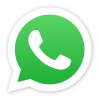A chimney is an architectural ventilation structure made of masonry, clay or metal that isolates
hot toxic exhaust gases or smoke produced by a boiler, stove, furnace, incinerator, or fireplace
from human living areas. Chimneys are typically vertical, or as near as possible to vertical, to
ensure that the gases flow smoothly, drawing air into the combustion in what is known as the
stack, or chimney effect. The space inside a chimney is called the flue.
The height of a chimney influences its ability to transfer flue gases to the external
environment via stack effect. The height is to ensure the pollutants are dispersed over a wider
area to meet legal or other safety requirements.
As a result of the limited ability to handle transverse loads with brick, chimneys in houses
were often built in a "stack", with a fireplace on each floor of the house sharing a single
chimney, often with such a stack at the front and back of the house. Today's central heating
systems have made chimney placement less critical, and the use of non-structural gas vent pipe
allows a flue gas conduit to be installed around obstructions and through walls.
Most modern high-efficiency heating appliances do not require a chimney. Such appliances are
generally installed near an external wall, and a noncombustible wall thimble allows a vent pipe
to run directly through the external wall.
On a pitched roof where a chimney penetrates a roof, flashing is used to seal up the joints. The
down-slope piece is called an apron, the sides receive step flashing and a cricket is used to
divert water around the upper side of the chimney underneath the flashing.
Our company has over 10 years' experience!
-
Opening time
24/7
-
Address
11 Chestnut St, Elmwood Park, NJ
-
Call us anytime
(+1) 862-390-1888

Chimney
Rebuilt/Replacement
This option completely removes the existing chimney and replaces it with a new
chimney. It is
the most expensive option but may be necessary if the existing chimney is beyond
repair or is a
safety hazard.
1. Plan the Chimney : Determine the chimney location and desired materials. Most
chimney
installations will require
permits and inspections.
2. Build the Foundation : Chimneys need to be built on a solid foundation, so a
concrete pad
will need to be poured or a
precast foundation will need to be installed.
3. Add the Crown : For mortared chimneys, add a rounded mortar crown at top to
facilitate water
drainage.
4. Construct the Chimney : Build the chimney with materials such as brick, stone
or
metal.
Chimney
5. Install the Flue : As the chimney rises, install the clay flue blocks in the
center of the
chimney to carry away
smoke and fumes.
6. Install the Flashing : On the roof, install the chimney flashing—the metal
apron that
encircles the chimney at its base
to prevent leaks and water damage.
7. Install the Cap : Install the chimney cap. This is the metal cover on top of
the chimney that
prevents water,
debris and animals from entering the chimney.
8. Test the Chimney : After installation, test the chimney to ensure that it is
properly
drawing.

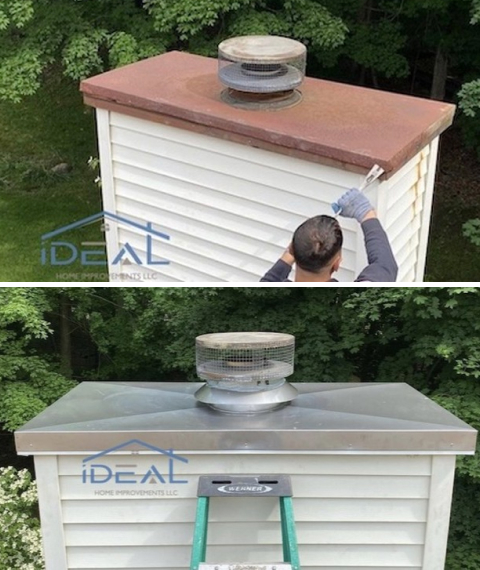
Chimney
Repair/Restoration
Will help prevent the risk of fire, leaks and improve the overall look of your home. Chimney rebuilds can be partial or complete. Chimney Repair could include a variety of different things, rom tuckpointing (filling in the mortar between the joints, where the mortar has eroded), or fixing a chimney liner when it has been damaged or is old and needs replacing.Getting your chimney fixed, especially in North/Central Jersey ,where there is so much freezing and thawing happening is very important. Leaving it can lead to leaks where water comes into the house through the chimney which in turn leads to unnecessary expenses! Sometimes part of the chimney would need rebuilding, but you must ensure that when the top part of the chimney is rebuilt the bottom part must be solid and in good shape or it is pointless. The bottom part will erode further and you will end up having to rebuild the gas chimney linerwhole chimney later on. Ideal Home Improvements will do a full inspection of the chimney and ensure that what you need gets communicated and the job is done right the first time!
Chimney
Re-Lining
A flue lining in a masonry chimney is defined as “A clay, ceramic, or metal
conduit installed
inside of a chimney, intended to contain the combustion products, direct them to
the outside
atmosphere, and protect the chimney walls from heat and corrosion.”
Although building codes vary from one state or locality to another, the
installation of flue
lining has been recommended since the early part of this century, and indeed
most fire codes now
mandate liners.
In the 1940’s and again in the 1980’s, masonry chimneys were tested by the
National Bureau or
Standards for durability due to rising concerns about their performance and
safety. The tests
revealed that unlined chimneys were so unsafe that researchers characterized
building a chimney
without a liner as “little less than criminal”.
Chimney liners serve three main functions:
1. Protecting the house from heat transfer to combustibles. In the NBS tests,
unlined chimneys
allowed heat to move through the chimney so rapidly that the adjacent woodwork
caught fire in
only 3 1/2 hours.
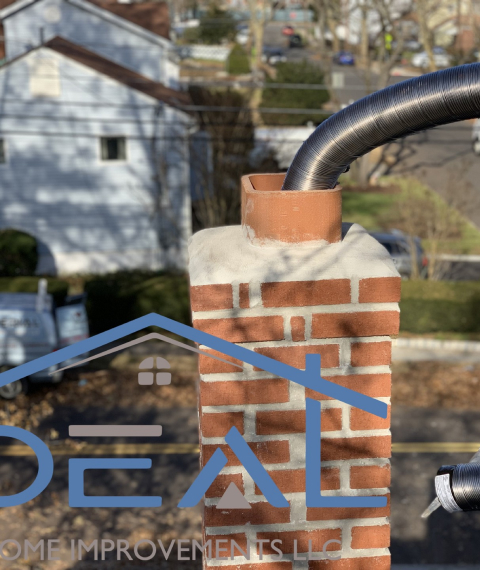

Chimney
2. Protecting the masonry from the corrosive byproducts of combustion. In the
tests it was
determined that if the flue gases were allowed to penetrate to the brick and
mortar, the result
would be a reduction in the usable life of the chimney. The flue gases are
acidic in nature and
literally eat away at the mortar joints from inside the chimney. As the mortar
joints erode,
heat transfers more rapidly to the nearby combustibles and dangerous gases such
as carbon
monoxide can leak into the living areas of the home.
3. Providing a correctly sized flue for optimum efficiency of appliances. Modern
wood stoves and
gas or oil furnaces require a correctly sized flue to perform properly. The
chimney is
responsible for not only allowing the products of combustion a passage out of
the house, but the
draft generated by the chimney also supplies the combustion air to the
appliance. An incorrectly
sized liner can lead to excessive creosote buildup in wood-burning stoves, and
the production of
carbon monoxide with conventional fuels.
Chimney
Types of chimney liners:
* Clay tiles are the most common type of masonry chimney liners.
* Advantages: They are inexpensive, readily available, and perform quite well
for open fireplace
chimneys that are properly maintained.
Disadvantages: They cannot rapidly absorb and evenly distribute heat during the
rapid
temperature rise that occurs during a chimney fire, causing the flue tiles to
crack and split
apart (see the video below). The second disadvantage is that tiles cannot
adequately contain the
liquid combustion byproducts produced by modern gas appliances.
Metal chimney liners, usually of stainless steel or aluminum, are primarily used
to upgrade and
repair existing chimneys.
* Advantages: If properly installed and maintained, metal chimney liners are
extremely safe and
durable. Stainless steel is suitable for wood-burning, gas, or oil appliances,
while the
aluminum is an inexpensive alternative for certain medium efficiency gas
applications only. It
is usually required that high temperature insulation be used in conjunction with
the liners for
safety and performance considerations.


Chimney
Re-Lining
* Disadvantage: Considerably more expensive than clay flue liners.
* National Chimney offers a line of metal chimney liners that have been accepted
by CSIA as safe
for home use when properly installed.
* Cast-in-place chimney liners are lightweight, cement like products that are
installed inside
the chimney forming a smooth, seamless, insulated passageway for the flue
gasses.
* Advantage: They can improve the structural integrity of aging chimneys, and
are permanent
liners suitable for all fuels.
* Disadvantage: Challenging installation and could be cost prohibitive.
Considering the dangers of old unlined or damaged chimneys, and the many cost
effective options
now available to make these chimneys safe components of the home heating system,
we encourage
you to have your chimney professionally inspected by a local CSIA Certified
Chimney Sweep an an
annual basis to be sure it meets modern safety standards.
Chimney
Inspection
We, Ideal Home Improvements Llc offer different level of chimney inspections,wood
burning or gas
burning.
There are approximately 20,000 chimney fires in the U.S. every year. We often
forget about the
important role our chimneys play during the warm summer months, but they provide
a lot of value
during harsh winters. It is important to have your chimney inspected annually to
ensure it is in
tip top shape before you light your first fire.
Here are five major reasons why each homeowner should inspect the chimney at
least annually
before start using it.
1. Prevents a potential fire: One of the biggest reasons to get your chimney
inspected is to
help prevent a potential fire. Chimney fires are mainly caused by creosote which
is a highly
flammable substance that begins to stick to the chimney walls over time. This
can be extremely
dangerous if it is not taken care of in a timely manner. A thorough chimney
cleaning will remove
this substance from chimney walls.
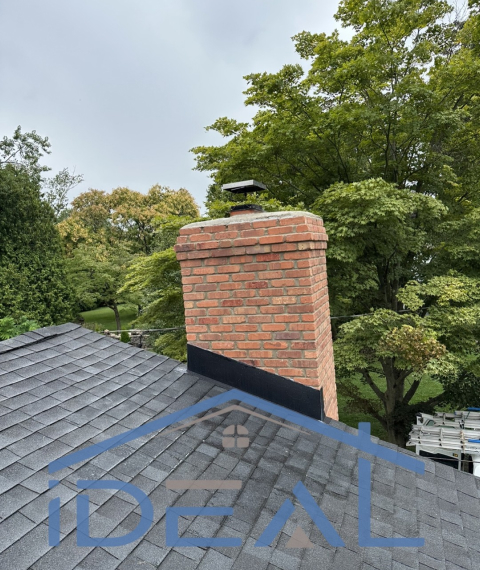

Chimney
2. Keeps pesky animals out: Animals such as squirrels, birds, racoons love to
hide and nest in
dark safe places and chimneys fit the description perfectly. Although this is a
plus for them,
it is a big negative for you. These animals can create a lot of issues for your
chimney. The
habitats they create inside cause the chimney to be unable to vent properly
which can lead to a
blockage. A chimney inspection will help identify nests and possibly remove
them.
3. Lowers carbon monoxide risk: Carbon monoxide can be very dangerous. It is
important to not
only have detectors inside your home, but to also have a professional check for
any trace of CO2
during your chimney inspection. Carbon monoxide can begin to build up in your
chimney’s flue,
giving the poisonous gas nowhere to flow out of so. Consequently, it begins to
leak into your
home, creating a major safety concern.
Chimney
4. Gets rid of any lingering odors: Chimneys can begin to give out an unpleasant
odor if they
are not cleaned regularly and properly. During the summer months, it is more
common that you may
begin to discover an odor due to the fact that the weather is warmer and more
humid than usual.
If you begin to smell any type of odor coming from your chimney, it is important
to call a
professional right away to have it inspected.
5. Longer lasting chimney: Getting your chimney inspected annually can
drastically extend the
life of your chimney, especially if there has been any recent damage. An
inspection will help
save you money in the long run by allowing you to fix any issue promptly so they
don’t become a
larger, more expensive, fix overtime.
The peace of mind knowing that your chimney is working efficiently and you and
your family are
safe from any potential dangers is well worth having an annual inspection done.
It is one of the
major items to prepare your home for fall!

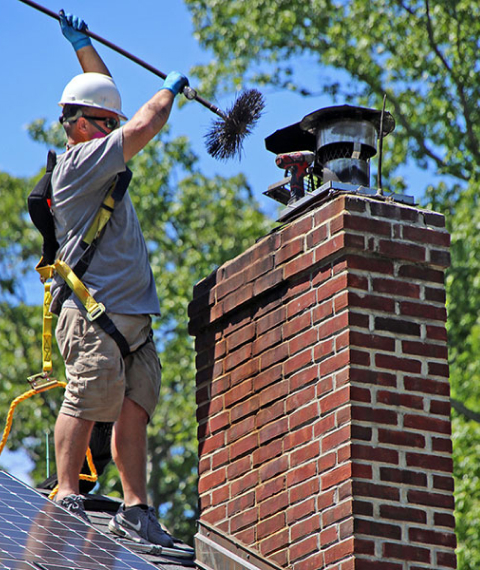
Chimney
Cleaning
Chimney Sweeping
The purpose of having a chimney sweep performed is to remove soot and creosote
from the inside
lining of a fireplace flue. The majority of sweeps are done from the inside of
the home because
this is the only way to gain access to certain areas of the smoke chamber and
flue. The smoke
chamber is a large cavernous area located directly above the damper, and is one
of the most
important areas when sweeping a chimney. Specialty rods and brushes ensure a
complete cleaning
of the chimney from firebox to chimney cap. Sweeping a chimney is a dirty job,
proper equipment
is a must. An industry specific vacuum is running the entire time the sweep is
being performed
to guarantee a spotless work area, and absolutely zero mess for the homeowner.
Chimney
Wood-burning Fireplace repair
Like every other appliance, wood burning fireplaces come with common concerns and
issues that
need to be taken into account, and problems that need to be dealt with promptly.
Here are the
top 10:
#1 Lack of maintenance, cleaning, and inspections.
No matter the age of your wood burning fireplace, it’s vital that you keep up
with annual
inspections and service. If every homeowner made maintenance, regular cleanings,
and annual
inspections a priority for their wood burning fireplace, the number of chimney
fires would drop
exponentially, and there would be very few issues.
Annual maintenance and service will help prevent problems with your wood burning
appliance and
allow you to address issues while they’re still small, so you can safely enjoy
the warmth it
provides. If you’re considering having a wood burning fireplace installed,
consider the amount
of maintenance required, and make sure it’s manageable for you before you
purchase.
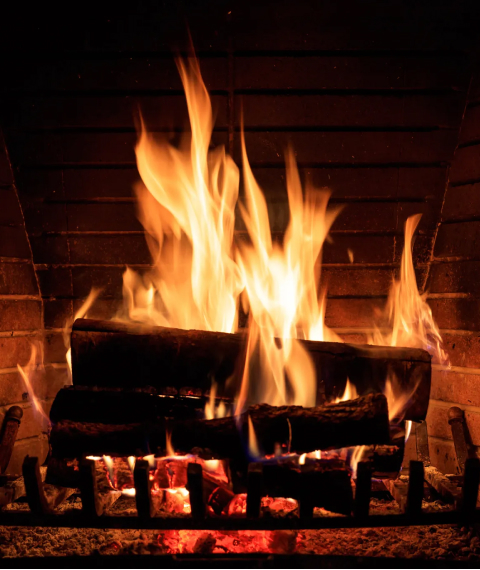

Chimney
#2 Opening the damper/proper operation.
When we get calls because a wood burning fireplace isn’t working, the most
common reason is that
the homeowner doesn’t understand the function of the fireplace damper or how to
open it. If the
damper — the metal plate between the fireplace and chimney — is closed, smoke
will have no way
of exiting the home, and it will appear as if your fireplace isn’t working.
Before you light a fire in your fireplace, take a look up into the chimney and
make sure you can
see all the way up to the top. If you can’t, your damper is closed and needs to
be opened before
you build the fire. If you’re unsure of how to open your damper, check out these
tips. If you
still need assistance, just give us a call.
Chimney
#3 Improper installation of the fireplace.
Every factory-built or prefab fireplace has specific manufacturer’s instructions
for proper
installation that must be followed to the letter. If your wood burning fireplace
isn’t working
and you did the installation yourself, there’s a good chance that installation
is behind the
performance or safety problem you’re experiencing. The best thing to do is to
schedule an
inspection with a qualified chimney sweep and have the installation checked. And
always, always,
always leave installation to certified and experienced chimney professionals who
know what
they’re doing.


Chimney
#4 Water in the fireplace.
Water is, by far, the most damaging thing your fireplace comes into contact
with. Unfortunately,
leaks are pretty common, especially if annual maintenance is skipped, flashing
is damaged, or
the chimney is missing a cap. The good news is that chimney leaks and water
damage can be
prevented by taking some simple steps:
Have a big, outside mount chimney cap installed.Make sure flashing is installed
properly and in
good condition.Waterproof the brick of your chimney with a siloxane-based
sealant.
Chimney
#5 Improper repairs by unqualified contractors.
If the wrong person is doing the work, repairs could end up making even more
problems for you.
That’s why it’s important to always call a qualified, certified, and experienced
chimney sweep
when scheduling annual inspections, maintenance, and repairs. This will save you
time and money,
and give you the confidence to use your fireplace, without worrying about poor
repair work
causing efficiency, structural, or safety problems.


Chimney
#6 Burning green wood or trash in the fireplace.
Wood burning fireplaces are made to burn — you guessed it — wood. But many
homeowners burn trash
and other materials in their fireplaces. If you’re guilty of throwing used gift
wrap and other
paper products in your fireplace, it’s time to start recycling those things and
investing in
quality wood.
The wood you burn in your fireplace should have a moisture content of about
10-20%. Wood with a
higher moisture content is known as “green wood,” and is not ideal for fire
building. This type
of wood will always produce more smoke and make it seem like you have a
fireplace performance
problem, and will also lead to creosote production, which brings us to our next
common
issue.
Chimney
#7 Creosote buildup.
Creosote is a highly flammable substance that results when unburned wood
particles settle on the
flue walls inside the chimney. The problem with creosote isn’t just that it’s
damaging to the
chimney itself, but that it can easily be ignited during the regular use of your
fireplace. In
fact, the majority of chimney fires are the result of creosote re-igniting. The
best way to
avoid this is to schedule annual inspections and routine cleanings. Only burn
wood that’s properly
seasoned.
#8 Improper wood storage.
Another common issue with wood burning fireplaces has to do with the storage of
the wood itself.
Many homeowners keep their wood outside, uncovered, which allows bugs and even
termites to get
into the wood pile. When this happens, you end up bringing those insects into
the home with you
when you get fuel for your fire, which can be a serious problem — especially if
those insects
are termites.


Chimney
#9 Inefficiency.
A regular wood burning fireplace is an energy boss in the house. Considering the
amount of fuel
you put in, you get very little heat out of the fireplace, and end up losing a
lot of the heated
air that you paid for with your HVAC system up through the chimney.
While modern wood fireplaces and inserts are typically highly-efficient, the
reality is that
most traditional wood fireplaces are only about 20% efficient, and waste a good
deal of energy
and money.
#10 Potential for house fires.
Finally, wood burning fireplaces can be dangerous because there is always the
potential for a
house fire. Does that mean a house fire is inevitable? Absolutely not. As we
mentioned at the
very start of this post, scheduling annual inspections and routine service and
cleanings can
significantly reduce your risk of a house fire, so you can enjoy your fireplace
responsibly. You
have the power — you just have to make it a priority.
Chimney
Capping
One of the most over looked areas of chimney maintenance is a properly sized chimney cap. The reason a chimney cap is needed is because of rain and animals. Our caps are 100% stainless steel with solid bases that rest on top of the flue, screws dig into the flue tile that ensure no animal can pry the cap off. They also have a large lid to protect against even the heaviest of rainfalls.
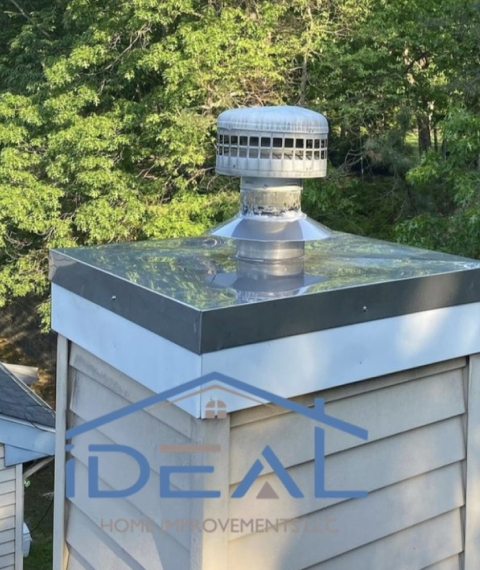
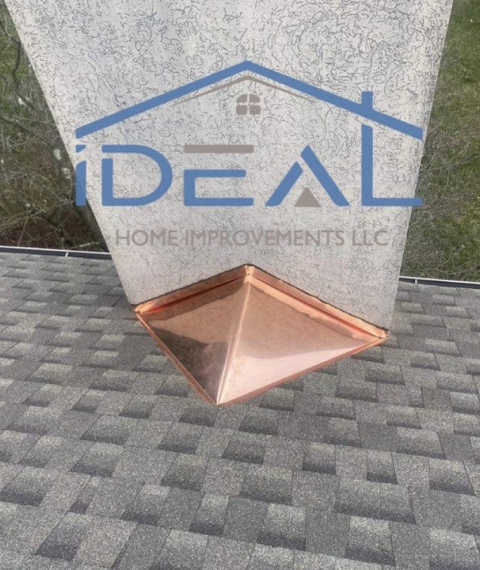
Chimney
Flashing
Flashing refers to thin pieces of impervious material installed to prevent the
passage of water
into a structure from a joint or as part of a weather resistant barrier system.
In modern
buildings, flashing is intended to decrease water penetration at objects such as
chimneys, vent
pipes, walls, windows and door openings to make buildings more durable and to
reduce indoor mold
problems. Metal flashing materials include lead, aluminium, copper, stainless
steel, zinc
alloy, and other materials.
Before the availability of sheet products for flashing, builders used creative
methods to
minimize water penetration. These methods included angling roof shingles away
from the joint,
placing chimneys at the ridge, building steps into the sides of chimneys to
throw off water and
covering seams between roofing materials with mortar flaunching.
Chimney
The introduction of
manufactured flashing decreased water penetration at obstacles such as chimneys,
vent pipes,
walls which abut roofs, window and door openings, etc. thus making buildings
more durable and
reducing indoor mold problems. It is also essential to prevent leaks around
skylights or roof
windows.[citation needed] Moreover, flashing is important to ensure integrity of
the roof prior
to a solar panel installation.
Flashing may be exposed or concealed. Exposed flashing is usually of a sheet
metal and concealed
flashing may be metal or a flexible, adhesive backed, material particularly
around wall
penetrations such as window and door openings.

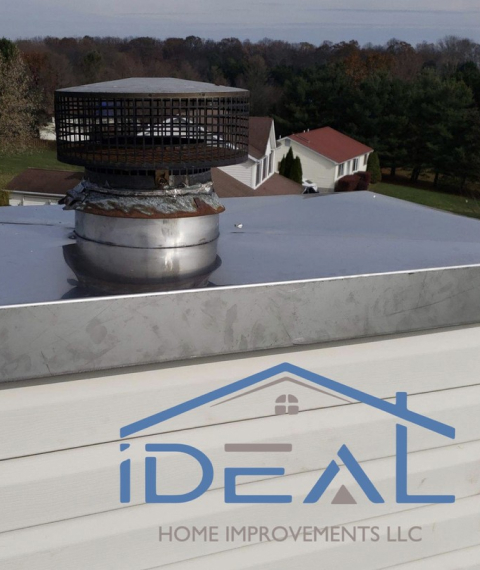
Chimney
Damper
When a throat style damper is no longer functional and a new damper is needed, we install the highest quality top seal damper. The reason a top seal damper is the preferred choice for damper replacement is because of the cost associated with throat style dampers. To install a new throat style damper, at least half of the firebox needs to be disassembled to be able to remove the old damper and install the new one. Our method is to install a top seal damper mounted at the top of the chimney, with a stainless steel cable running from damper to the firebox where new damper controls are mounted.
Chimney
Sealing
This barrier will prevent water from seeping into the pores of the masonry, which
can cause
cracks and other damage. A clear sealer will also protect your chimney from the
damaging effects
of UV rays, as well as pollutants and other debris that might be in the
air.
The materials used to construct a chimney are numerous. The outer layer is
masonry (bricks and
mortar) with an inner liner frequently made of fire-resistant metal.
Maintaining your chimney in excellent working condition requires regular
maintenance, which for
many homeowners means using a chimney sealant. Which type of sealer provides the
most durable
finish, while letting the beauty of the brick or stone shine through?
If you have a clear sealer on a chimney, it will protect your home from water
damage and keep
your property looking good for years to come. While there are many types of
clear sealers
available on the market, they are not all equal. Let us help you choose the best
clear sealer
for your chimney.
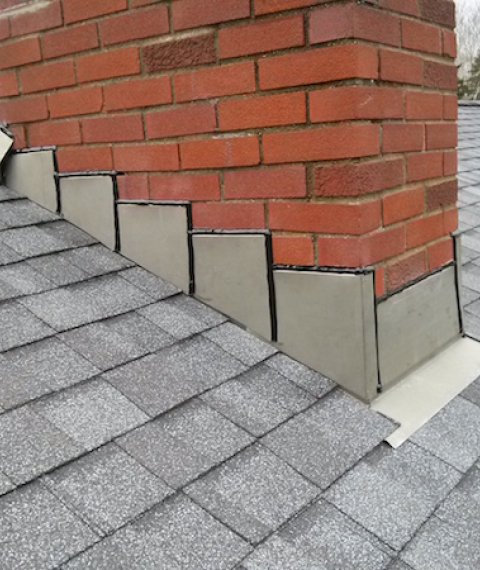

Chimney
Why Seal a Chimney?
Maintaining your chimney is a job that must be done regularly, and it entails
keeping moisture
out. The bricks in your masonry chimney will deteriorate faster if rain,
humidity and
condensation get inside. This is because the freeze/ thaw cycle causes the
masonry to decay.
Water expands the pores in a brick as it freezes. When the water thaws and
evaporates, there is
more room for water to fill the next time. This cycle repeats throughout the
winter months until
the bricks’ structural integrity is lost, causing fissures and eventually
detaching entirely.
This would mean more damage to repair the longer you wait to seal your chimney.
To fix cracks
and fissures, you would need to utilize masonry crack fillers, to fix any damage
before you can
waterproof your chimney.
Chimney
Even if you live in an area that rarely experiences a freeze/ thaw cycle,
preventing moisture
from penetrating the brick or stone of your chimney is still necessary. Mold
thrives in dark,
damp and isolated places. Unfortunately, your chimney might be one of those
locations.
Mold can cause various health problems for people. Asthma and allergies are
associated with mold
growth, as well as more serious illnesses like respiratory infections and lung
disease. Aside
from that, mold can damage your chimney and necessitate costly repairs! Mold can
be easily
avoided by properly sealing your chimney.


Chimney
Protect from Moisture
Clear sealers are designed to create an invisible barrier between the masonry
and the outside
elements. This barrier will prevent water from seeping into the pores of the
masonry, which can
cause cracks and other damage. A clear sealer will also protect your chimney
from the damaging
effects of UV rays, as well as pollutants and other debris that might be in the
air.
Retain Aesthetic for Long Term
Clear sealers are also effective at repelling stains, which can make your
chimney look dirty and
unattractive. The right clear sealer will help your chimney maintain its
aesthetic appeal for
years to come.

